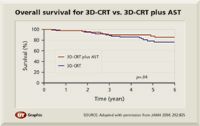Article
Short-term androgen therapy plus RT boosts survival
A 6-month course of androgen suppression therapy following radiation treatment for clinically localized prostate cancer confers survival benefits similar to those seen with longer courses of androgen blockade (>3 years), according to a recent study from Brigham and Women's Hospital and the Dana Farber Cancer Institute, Boston. The study also suggests that only partial blockade with a luteinizing hormone-releasing hormone (LHRH) agonist may be sufficient.

"The current standard for men with localized but high-grade disease treated with radiation is long-term hormonal therapy, perhaps 2 or 3 years of treatment. This study challenges the concept of whether or not 2 or 3 years of treatment are really needed," said principal investigator Anthony D'Amico, MD, PhD, professor of radiation oncology at Brigham and Women's Hospital.

All patients received 70 Gy three-dimensional conformal radiation therapy. Approximately half (102 patients) received an LHRH agonist (leuprolide acetate [Lupron] or goserelin acetate [Zoladex]), and 98 of these also received the nonsteroidal anti-androgen flutamide (Eulexin). Notably, 27 discontinued flutamide owing to adverse effects. However, these patients remained in the study.
After a median follow-up of 4.52 years, patients treated with 3-D conformal radiation therapy plus androgen therapy showed an 88% 5-year survival rate compared with a 78% 5-year survival rate in patients only receiving 3-D conformal radiation therapy. There were no deaths due to prostate cancer in the combination therapy cohort, whereas there were six deaths due to prostate cancer in patients receiving only radiation therapy.
Rates of survival free of salvage androgen suppression therapy were 82% at 5 years in the combination therapy group compared with 57% in those receiving only radiation therapy.
"Those most likely to benefit from these findings are men with a Gleason score of 7 or higher or a PSA between 10.0 ng/mL and 20.0 ng/mL," Dr. D'Amico said. "The study included a heterogenous group, but the vast majority in the study were in this so-called intermediate-risk group."
If subsequent studies confirm the current findings, the use of short-course androgen suppression therapy in localized prostate cancer would represent a major therapeutic advance, Dr. D'Amico said. Androgen suppression therapy greater than 1 year may be associated with osteopenia, memory impairment, anemia, muscle loss, and erectile dysfunction, among other side effects, he said.
However, while answering some questions, Dr. D'Amico said the study raised others. He noted that, when the study was initiated about 6 years ago, 70 Gy was the standard radiation dose. Since then, several studies conducted with new imaging and radiation delivery systems indicate that higher doses-up to 86 Gy-confer additional benefits.
"The clinical trial we are now running utilizes higher [radiation] doses with 6 months of hormone suppression," he said. "This is one of the next questions we need to answer. Do higher doses further add to the benefits we have seen?"
Newsletter
Stay current with the latest urology news and practice-changing insights — sign up now for the essential updates every urologist needs.

















